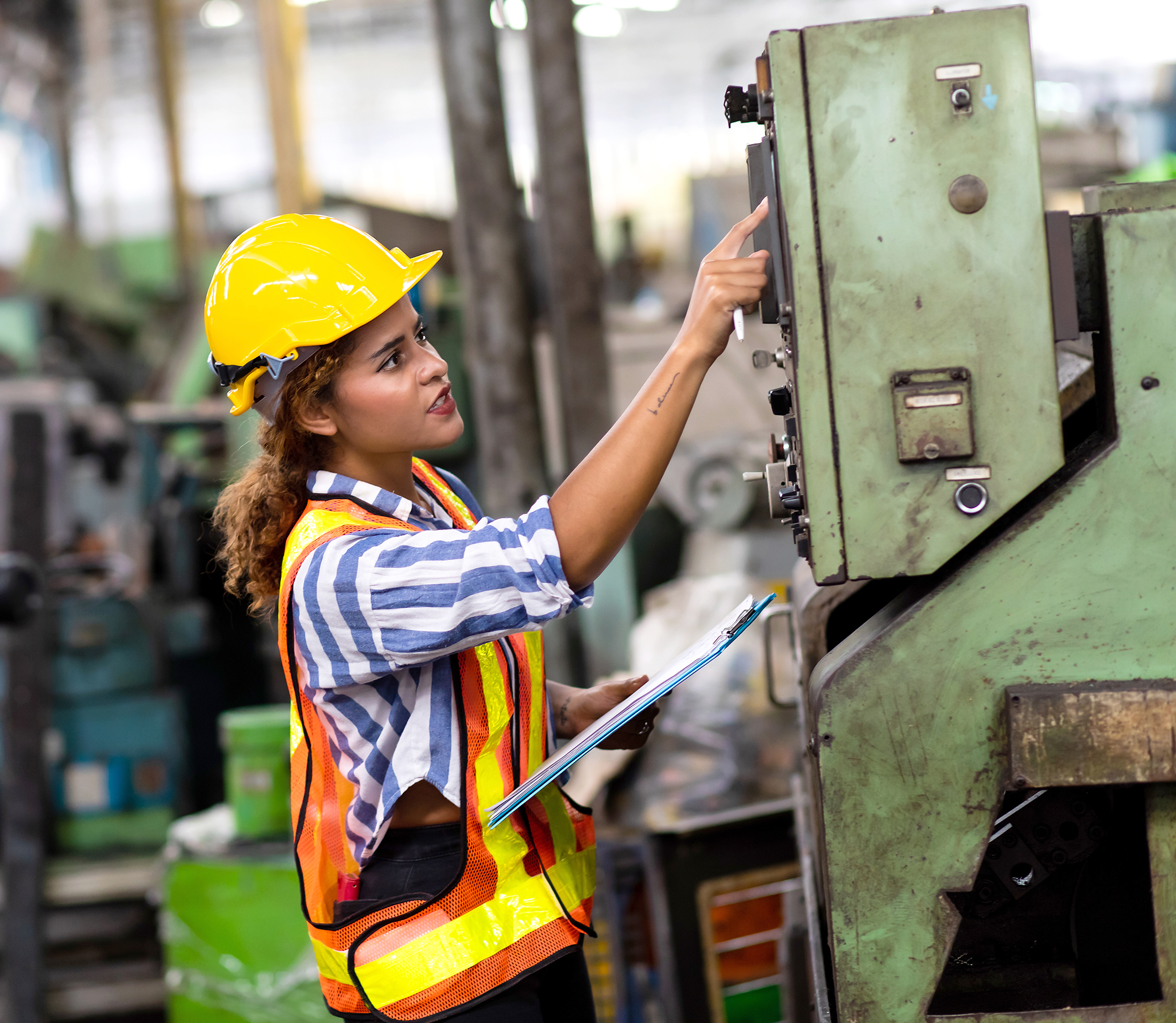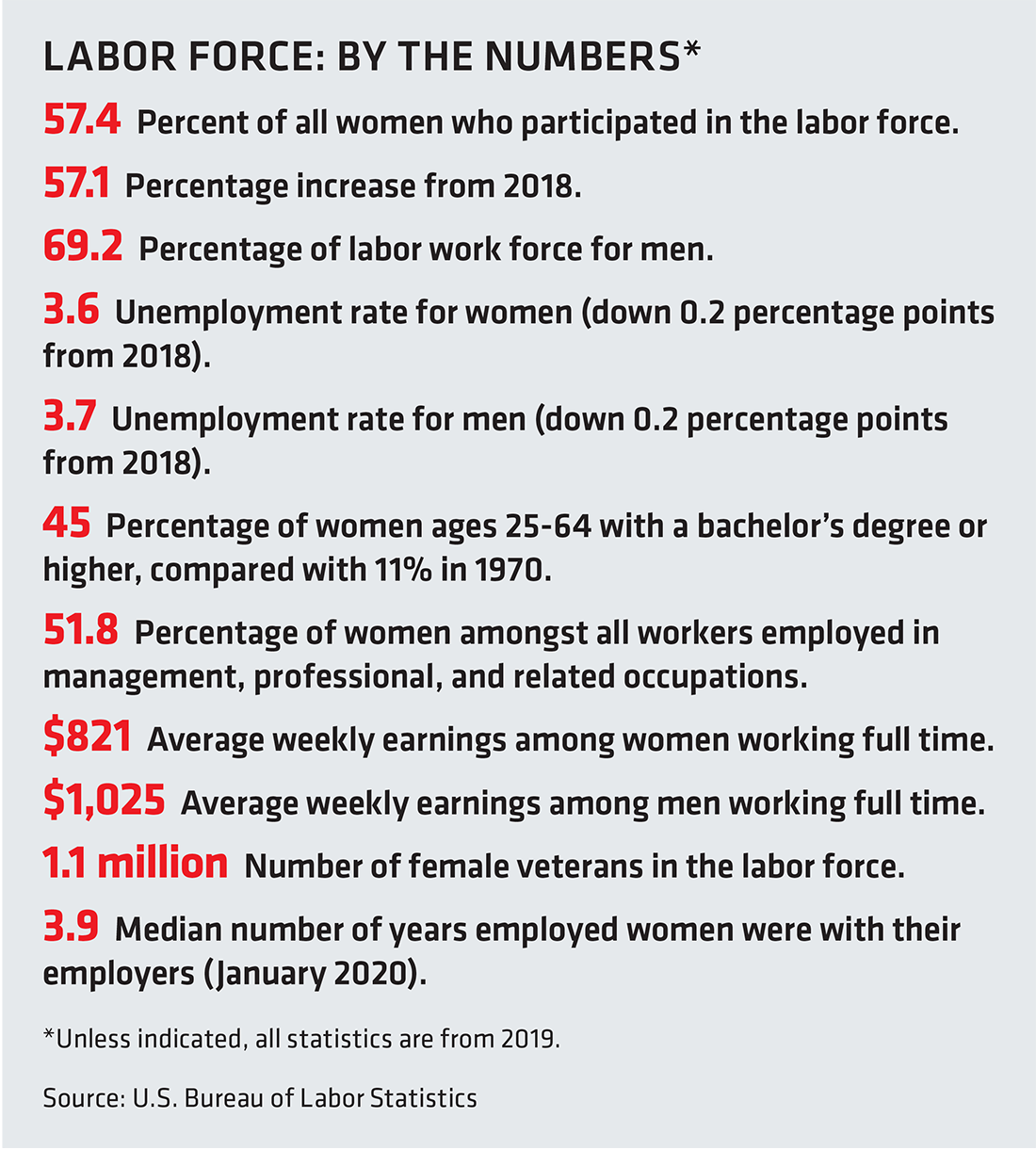You don’t have to go very far back in time to find a point where the role of women in the manufacturing sector was practically nonexistent. But over the last decade or so, the ratio of women to men has seen a dramatic increase, although those statistics still have much room for improvement.
Diversity in any industry is always a good thing, but in an area that has been — until recently — traditionally dominated by men, an influx of women who can offer different perspectives can only be a boon to a company’s innovation, as well as its bottom line.
With the dynamics and environment within manufacturing companies changing, it becomes even more imperative that young girls who express an interest in the field be given every opportunity to allow that spark to grow.
“I’ve worked in several industries during my career, and while some have a lot of women employed in their businesses, there is still very much a good ol’ boy network,” said Lori Brown, sales manager for IMT Forge. Brown has been entrenched in the world of manufacturing solutions for aerospace, defense, and industrial markets for the last 12 years. “For example, I worked in sport education for my previous job. When you deal with football or baseball coaches, they don’t like a female training them on how to coach kids, whereas I didn’t notice that as much when I came on board IMT Forge. I would say in our office, which we probably have at any given time anywhere from 40 to 50 office personnel, that about 10 percent of the office was women when I started 12 years ago. Today, it’s probably 70 percent women — and they’re in leadership roles.”
That shift is also showing up in higher education, which can often lead to a prominent position in manufacturing.
“Even in the last 10 years, I would say that women definitely have a more apparent presence, but they’re still vastly underrepresented compared to how many men are in the field,” said Corinna Draghi, applications and design engineer with Atlanta Gear Works. “That is something that honestly will just take time. Something that I have noticed is that STEM in general, science, technology, engineering, math, all that stuff, is pushed a lot more toward the girls in schools from an early age. At Georgia Tech — where I was a freshman years ago — our ratio of men to women was approximately one woman for 10 men on campus. It was outrageously backwards. I think now it’s more like one to three, so the numbers have gotten better, but that’s not to say they’re all in manufacturing. We still have a long way to go in terms of women in manufacturing specifically. There are not enough of us. And the ones that I do see on the shop floors, when I go to the plants, a lot of the times, they’re not the ones getting dirty.”
 Making opportunities known
Making opportunities known
But as more opportunities manifest themselves early on, that can only mean the presence of women in manufacturing will continue to grow. But much of that growth is dependent on bringing those opportunities for women front and center.
“One way you can do that is by looking at your benefits: What it is that women need? What kind of support do they need? What’s going to attract them to the workforce? And it could be a variety of things,” said Veronica Lancaster, vice president of standards programs in the Technology & Standards Department of the Consumer Technology Association. CTATM is North America’s largest technology trade association, which helps support more than 18 million U.S. jobs. “It doesn’t have to be your traditional healthcare, although that’s very important. It could be more personal time that you need — depending on your job in the manufacturing industry, obviously. It’s hard to work from home if you need to be on the floor, but you could modify your hours. You could allow for early starts and later starts, bringing more flexibility.”
Importance of mentoring
Lancaster also points out the importance of mentoring programs.
“It is valuable to bring together women in your organization,” she said. “If you have someone who has been there for a while, pair them up with a newcomer. This also creates meaningful opportunities for reverse mentoring. If you have someone more experienced who can teach a new professional, chances are they are going to teach something in reverse as well. It’s a valuable relationship.”
That mentoring program can also be a useful tool in college as well, according to Draghi.
“If more women could find a mentor, someone in the field who could help them kind of get there faster, to be a filter through all of the other noise to help figure things out, that would help a lot,” she said.
Brown, Lancaster, and Draghi took part in a recent panel on Women in Manufacturing at the Motion+Power Technology Expo in St. Louis, Missouri, in September. During the panel discussion, they talked about the importance of women in the manufacturing sector and what it could mean to a company’s performance.
“What do we do about that? I mean, diversity, equity, and inclusion are obviously some of the areas that you should focus on, and each industry has different challenges,” Lancaster said. “But some of the things that I learned as a panelist had to do more with some leaders not understanding, ‘How do we do this exactly? How do we target in this sector?’”
Varying ways to recruitment
The good news is there are multiple avenues in which companies can explore to recruit more women.
“Companies can take a look at how they do things and how they might participate,” Lancaster said. “If there’s a fixed sector of the manufacturing company that is predominantly male, they might offer incentives to recruit women on staff and then pair them with someone that can be more of a partner. Sometimes, when you think about those old boys’ clubs, it can be intimidating. So, having that freedom to feel like you can speak up, offer your expertise, guidance, and having a partner on the floor can inspire confidence.”
New personalities can often lead to personality conflicts, but Draghi said that many times that potential conflict might never exist in reality.
“It’s kind of weird because, when I first started, I honestly was less weirded out by it than the guys were. They were like, I know it’s weird but, ‘There’s a chick here.’ And I’m like, ‘Yes. Hi.’ Once they get to the point where they know you know what you’re doing, you’re just one of the guys,” she said. “And I’m honestly fine with that. I don’t really necessarily mind it being a men’s club because there’s not really any exclusion there. They don’t prevent me from being part of things. I go to lunch with them; I hang out with them. Some of the guys here actually have invited me to things with their family. So, there is inclusion, but I think a big thing for them in their ‘men’s club’ is you have to know what you’re doing. If you cannot prove you know what you’re doing, if you cannot prove you’re capable and competent, then they don’t have anything to do with you — guy or girl.”

A tricky journey
Anecdotally, women’s roles in manufacturing are becoming more commonplace, but the journey to get there can still be a challenge to navigate, according to Lancaster.
“Expecting diversity and looking for ways to make sure you’re integrating women can be tricky as well,” she said. “I think if you are going to offer benefits or signing bonuses or something else to try to diversify your workforce, that could cause some friction on the other side. It has to be handled carefully.”
Sometimes that can be as simple as building on what is already there, according to Lancaster.
“From my perspective, both in standards and technology, I see that changing,” she said. “What I’ve found, and some of this has happened organically for me speaking on the standards side, when I first started 25 years ago in telecom — some areas had women involved, like ordering, billing, things like that. But once you got more in depth into some of the networking or timing and synchronization, that was very male heavy. What I tended to do was gravitate toward the other women who were there. We could talk together about the problems that we were having — whether it’s not feeling like you have a voice or not feeling like we have a lot of allies. And slowly those networks grew.”
More than just a gender issue
There are many additional issues that often manifest beyond gender, Lancaster said. Those can include different nationalities, different religions, or different comfort levels.
“Even in business, you have different roles,” she said. “Some roles in China and Japan, for example, are more male dominated by tradition, and it’s tough for women to break into those roles. But I’m starting to see some change with women in traditionally male roles. In one group that I’m in, the head of the delegation from China is a woman, and that’s highly unusual. So, we’re seeing more change, and I think that is encouraging.”
Emotional differences can also be an issue, but they don’t necessarily have to be a detriment, according to Brown.
“Definitely women are more emotional, and you heard that from other panelists; I struggle with being overly emotional myself,” she said. “I do feel like we do see a lot more outward strength from male leaders, but if they’re smart guys — and I do work, luckily, around a lot of smart men — I think they’re open to good ideas. If you have a business case, and you stand your ground, and you put forward thoughtful, factual information, they’re going to go with your idea. And if I start crying in a meeting, that’s usually when I get told ‘no.’ There’s no crying in forging after all.”
Companies seeing the positives
Draghi pointed out that conservative companies — and the manufacturing world is full of conservative companies — are more willing to hire women in a huge push for global inclusion simply because these companies have come to the realization that women process things differently than men, and that can be advantageous.
“And vice versa — I’ll see things that the guys don’t see; they’ll see things that I don’t see,” she said. “I’m one of three job engineers, and I’m the only female. My boss is also a male. So, they’re seeing, as I’ve been here, that I can handle myself on the floor, and I also see things differently than they do, or I’ll catch some more detail-oriented things. I see the push for just women in general, and I guess I never really noticed the lopsidedness of it. I never really thought that women didn’t have as much opportunity because my dad was the reason that I got into manufacturing. He was like, ‘If you want to do it, you can do it. You’re good at math. Go for it.’ There was never a question, but I was lucky in that aspect. Not everyone has that.”
 Dismantling stereotypes
Dismantling stereotypes
Companies are also rethinking whether women should be on the shop floor because of the cliché that women may be too sensitive and can’t handle the environment, according to Draghi.
“That’s not always the case, and I’m a prime example of that,” she said. “I am probably one of the least sensitive women you’ll ever meet, and that’s why I can handle it. And (companies) are realizing that you need to interview everybody, meet them in person, talk to them, see what their personality is. And one of the big things that our company did when I was hired was a personality profile. And I think that is something that would massively help other companies that are struggling to add women to their workforce. It would definitely help everyone to see, ‘OK, there are some women that line up with these men in terms of personality, and they will mesh with our company well.’ And I think that is a big factor. If more people did that, they would see a difference when they interviewed those women. Honestly, most of the companies that I’ve seen that are willing to hire, and are actively hiring, women in manufacturing already do it. I think that’s a big thing.”
Despite some challenges, Brown said there are a plethora of opportunities for women who want to be a part of the manufacturing world.
“I think there are tons of areas that women can contribute in manufacturing, but what I think we are lacking most is attracting younger people,” she said. “I don’t think companies have evolved to really show the younger generation how awesome this industry can be. You don’t need an engineering degree, but you do need to have critical thinking skills. My daughter’s 28, and she’s a wonderful, bright, creative person. But when she came to my job, she said, ‘This place is scary. It’s like going to the depths of hell.’ You’re dealing with steel, and you’ve got metal shavings, and you hear this pounding all day long. It’s a little intimidating. Our building shakes where I work, because we make big parts, and we’re constantly banging them out.”
Brown said IMT Forge’s current production manager, who is a woman, started as a customer service representative.
“She’s a very strategic thinker, and she has moved her way up, now managing at least four different disciplines in our company,” she said. “No doubt she’s one of the key leaders in our facility and has really helped us improve in so many ways. So, how do we get more people like her? I recruited her because I just saw her spunk. I knew her personally, but she would’ve never thought to apply. She didn’t even know what a forger was. When I talked to several people at the Motion+Power Tech conference, I heard a lot of folks say, ‘It’s not even enough going to the colleges to recruit younger people, because that’s too little, too late.’ We need to get these kids when they’re in high school. And definitely I think when you have a mix of men and women, young and old on a team, you’re going to be more successful because we are different.”
Reaching out at the high school level
Lancaster also agreed that it is important to approach girls while they’re still in high school and let them know the possible career paths that manufacturing can offer.
“In the panel that we were on, there was a question from the audience, and a gentleman asked about mentoring and a science club that he was involved in,” she said. “That hit home for me. One issue that you see, especially in jobs like mine geared toward engineering, is you really focus on STEM. I would say manufacturers that are sponsoring STEM education should get more involved with kids and create women’s or girls’ STEM clubs. If you’re able to create girl-focused STEM clubs that provide an environment where girls feel comfortable to speak and don’t feel under pressure, that is going to help create confidence.”
That can also circle back to mentoring, according to Lancaster.
“If you see a really talented young woman in your program, work with her,” she said. “Help her and mentor her. You might be inspiring the next engineer that’s going to come work for your company. Those same companies can create college sponsorships or college scholarships, which help women advance, then continue guiding them through their college careers.”

Getting more women on the shop floor
Beyond that, the women who are already working “in the trenches” of a shop floor are wanting to see even more women join their ranks, and Draghi said companies are willing to take that chance more now than they have in the past.
“I mean, the worst that it’s going to do is you’ll spend a little time training them and realize it doesn’t work out,” she said. “From what I’ve seen, it can work out, but you will never know if you do not try. I do have a few women friends from Georgia Tech: One of them was working on electric motors for a while on a shop floor as a project engineer. Another one of them did electrical engineering, and another one does a lot of software engineering. But there are still companies that are pushing for that. And I think that they’re trying it; it’s not necessarily going as fast as they want. You’re not going to hire 10 women right away. It’s going to be like a one off: one here, one there.”
A surprising obstacle that many women looking for manufacturing jobs may face is that some companies just aren’t tuned in to the need to diversify their workforce at all, according to Draghi.
“You don’t want to have to force them to make the extra effort to try because then you feel like you’re forcing something on them, but at the same time it might be completely unintentional that they are not actively hiring women. The companies may just not realize it,” she said. “They’re just not looking at those applicants, or they’re not getting them because they’re not advertising, ‘Hey, we want women in our workforce.’”
Fear of rejection
But a far more personal obstacle can be fear of rejection that keeps women from applying for a manufacturing job in the first place, according to Draghi, where they may assume a company is not looking to actively add diversity to its workforce.
“Get rejected, move on, try again — that’s my opinion, but not everyone sees it that way,” she said. “And there are so many people that have that innate fear of rejection, and they’re so worried about someone telling them no, that they just won’t try. If I was that terrified of it, I never would’ve ended up where I am. You cannot grow. You cannot become a better engineer or employee in general, if you don’t have some type of rejection or failure, or if you’re not told no. You cannot learn what you’re supposed to learn. You cannot grow in your professional career without that there because, otherwise, you’re going to stay the same forever; nothing’s ever going to change, and you’re not going to see things differently or understand your mistakes.”
But when companies open their doors to more women joining their organizations, it can also open up new and innovative ideas and opportunities, according to Lancaster.
“I think what you’ll start to see is diversity in opinion, diversity in work style, and maybe just overall change in how you may address certain things,” she said. “And it could be that you’re seeing more entry level women coming in. You’re seeing women on different executive paths, more training. And as you’re seeing all of these three come together, you’re going to see that diversity of opinion. So, where you may have had a very male, ‘we’re here to work,’ strict kind of a perspective, you may get a better understanding of, ‘Yeah, well, we’re here to work, but we’re also here to build a future.’”
But to get companies to that point, you have to recruit the best applicants — men or women, and a more diverse team equals a more productive team, according to Brown.
“That’s just a real fact with no gray,” she said. “We’re very different. We’re not the same. But we each have strengths, and when you put all of those wonderful skill sets on a team: You need somebody to be passionate about the customer; you need somebody to be very diligent on the operations side. That balance is important, and studies have proven that when you have a mixed team, you’re going to be more successful as an organization.”






































